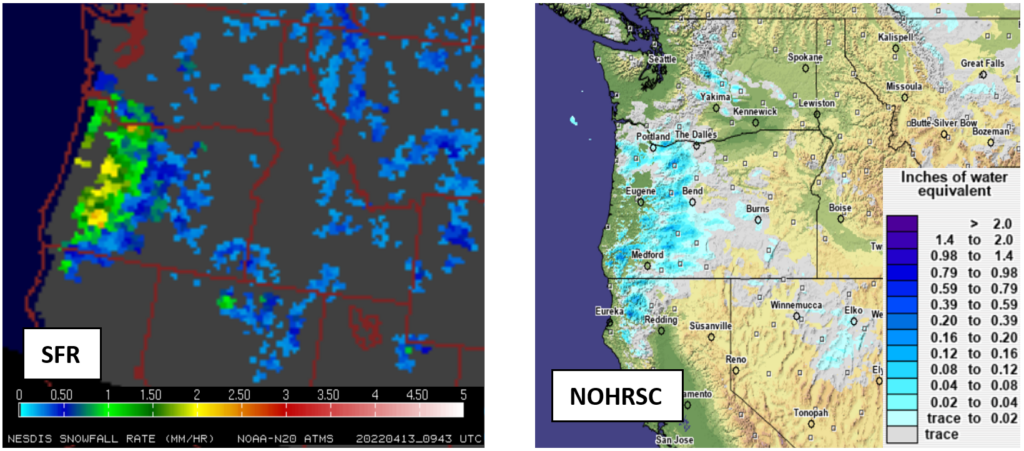The STAR scientist team of Huan Meng, Yongzhen Fan, Jun Dong, and Yalei You examined the performance of snowfall estimates from the passive microwave snowfall rate (SFR) product for the late season snowstorm that hit Washington and Oregon on April 13. The storm set the local record for most snow accumulation this late in the season, causing power outages and road closures across Portland, Oregon.
The SRF product correctly captured the snowstorm as shown in the figure below. The image on the left is SFR retrieved from NOAA-20 measurements, and the image on the right is the corresponding National Operational Hydrologic Remote Sensing Center (NOHRSC) interpolated ground observed hourly snowfall. SFR shows good agreement with NOHRSC in snowfall extent and intensity.

Figures 1 and 2: Snowfall rate from Pacific Northwest snowstorm on April 13, 2022, (left) NOAA-20 SFR, (right) NOHRSC
Meng is a physical scientist with NOAA/NESDIS Center for Satellite Applications and Research, Satellite Climate Studies Branch, and a Visiting Research Scientist at ESSIC. She received a MS in Physical Oceanography from Florida State University in 1993, and a PhD in Hydrology from Colorado State University in 2004. She has been working in the field of satellite remote sensing since 1999. Her current research focuses on snowfall retrieval using passive microwave measurements from polar-orbiting satellites.
Fan received the B.S. degrees in electronic science from Xi’an University of Science and Technology, Xi’an, Shaanxi, China in 2004 and the Ph.D. degree in Physics from Stevens Institute of Technology, Hoboken, NJ, USA in 2016. He is currently an Associate Research Scientist with the Earth System Science Interdisciplinary Center (ESSIC) and the Cooperative Institute for Satellite Earth System Studies (CISESS)-Maryland, University of Maryland (UMD), College Park, MD, USA. His research interests include radiative transfer theory, machine learning, satellite remote sensing of ocean color, aerosols and snowfall.
Dong is a faculty specialist at Earth System Science Interdisciplinary Center (ESSIC) and Cooperative Institute for Satellite Earth System Studies (CISESS)-Marylandof, University of Maryland. He received his Ph.D degree in Geophysical Fluid Dynamics from Florida State University in 2012. He has over fifteen years of experience in Methodology, Physical Oceanography and Remote Sensing. At ESSIC/CISESS, his work focuses on microwave satellite snowfall rate (SFR) retrieval algorithm development, implementation and real-time SFR product maintenance.
You received his B.S. and M.S. degrees in atmospheric science from Yunnan University, Kunming, Yunnan, China, in 2005 and 2008, respectively, and the Ph.D. degree in meteorology from Florida State University, Tallahassee, FL, USA, in 2013. He is currently an Assistant Research Scientist with the Earth System Science Interdisciplinary Center (ESSIC) and the Cooperative Institute for Satellite Earth System Studies (CISESS)-Maryland, University of Maryland (UMD), College Park, MD, USA. His research interests include passive microwave precipitation algorithm development, precipitation data set validation, and microwave instrument calibration. You has served as an Associate Editor for the Journal of Hydrometeorology and the Journal of Applied Meteorology and Climatology.






